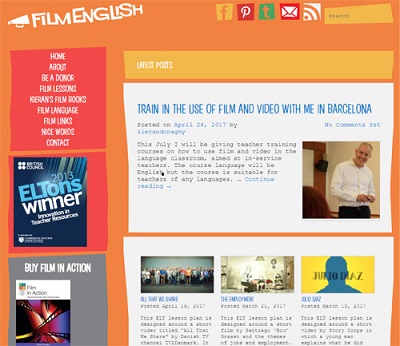- MN ABE Connect
- Archive
- Using Video to Develop Effective Communication Skills
 April 25, 2017
April 25, 2017
Using Video to Develop Effective Communication Skills
Stephanie Sommers, ACES CoordinatorUsing short video clips can be a very engaging way to create authentic listening practice for learners, but this can also be done through the use of podcasts, news broadcasts, and other media.
The advantage of video is that it can be used to teach a variety of effective communication skills by providing examples of gestures, body language, and other non-verbal communication that cannot easily be conveyed through sound alone. A drawback to using video is that it can be challenging to find just the right clip to support and reinforce whatever topic or skills is being focused on in the classroom. As a listening and speaking teacher, I was thrilled to recently learn of a resource that combines funny, poignant, powerful video clips with ready-to-use ESL lessons to support language teaching. The website is called Film English, and it is the newest resource to be added to the ACES resource library in the category of Effective Communication.
 The Film English website seems to have been started in 2010 by an internationally based English language teacher with a special interest in film. It is structured like a blog, and each post contains a film clip, a synopsis of the clip, and a detailed lesson plan about how to use the clip. A review of the blog posts shows that an average of 25-35 new posts are added each year, so there are currently right around 200 different clips and lessons available.
The Film English website seems to have been started in 2010 by an internationally based English language teacher with a special interest in film. It is structured like a blog, and each post contains a film clip, a synopsis of the clip, and a detailed lesson plan about how to use the clip. A review of the blog posts shows that an average of 25-35 new posts are added each year, so there are currently right around 200 different clips and lessons available.
It is completely free to use the lessons, and you don’t even need to create any sort of user account. It should be mentioned, however, that the website’s creator, Kieran Donaghy, rather aggressively advertises a book that he wrote on using film as a teaching tool, and he does appeal to the users of the website to invest in a copy of the book as a way to keep the website going. Apart from these messages that come from the website’s developer, the site is currently ad-free.
 I was impressed by the sheer variety of clips that the website pulls together, and I love that they come from a variety of sources and countries. There is a search feature that allows users to enter a key term and search for related clips. I searched by “health” and “employment,” and both times the search resulted in more than one relevant clip.
I was impressed by the sheer variety of clips that the website pulls together, and I love that they come from a variety of sources and countries. There is a search feature that allows users to enter a key term and search for related clips. I searched by “health” and “employment,” and both times the search resulted in more than one relevant clip.
I watched one of the videos related to my health search, and was absolutely charmed by what turned out to be a Coca Cola commercial. It showed a young, modern man and a man who was supposed to be his grandfather both going about their daily routines. The ad depicted the younger man driving to work, for example, while the grandfather rode his bicycle. While the younger man takes an escalator at work, the grandfather takes the stairs. Likewise, the younger man eats a quick lunch at his desk and goes home in the evening to eat a microwaved meal in front of the TV, while the grandfather enjoys his lunch outside and is treated to a home-cooked meal at the end of the day. The tag line was about living like your grandfather. The lesson plan that accompanies the clip instructs teachers to have their students discuss, among other things, the two different lifestyles represented in the ad focusing on comparison and contrast. Other lesson plans emphasize making predictions, and watching the video with the sound turned off so that students can tell their own version of the story.
I also watched a different clip on the site from a 2017 post called “Learning a Language.” It showed a man receiving a box of materials in the mail to help him learn English. The video goes on to show the man wholly committing himself to learning English by listening to practice tapes on the bus, at home, even in the bathtub. He also labels everything in his house with a Post-it note showing the word for each thing in English. Then another package arrives for the man, and this time it contains a suitcase. At the end of the video, the man arrives in a different house and greets a young boy whom he is meeting for the first time. “Hello,” the man says in English, “I am your grandfather.”
This video, which was both funny and tender, did contain one instance of profanity, so teachers might want to preview any clips before showing them in class. The lesson plan designed to support this clip encourages students to work in small groups to identify all of the different strategies and techniques the man uses to learn English. Then the students discuss what strategies and techniques they use.
With such a huge variety of film clips and lessons to choose from, I am looking forward to using the Film English website with my students for many class periods to come. I encourage you to check it out and discover how videos can be used to support language teaching and effective communication skills.
Newsletter Signup
Get MN ABE Connect—the official source for ABE events, activities, and resources!
Sign UpArticle Categories
- ABE Foundations/Staff Onboarding
- ACES/Transitions
- Adult Career Pathways
- Assessment
- CCR Standards
- Citizenship
- COVID-19
- Cultural Competency
- Digital Literacy/Northstar
- Disabilities
- Distance Learning/Education
- ELA
- Equity/Inclusion
- ESL
- HSE/Adult Diploma
- Listening
- Math/Numeracy
- Mental Health
- Minnesota ABE
- One-Room Schoolhouse/Multilevel
- Professional Development
- Program Management
- Reading
- Remote Instruction
- Science
- Social Studies
- Speaking/Conversation
- Support Services
- Teaching Strategies
- Technology
- Uncategorized
- Volunteers/Tutors
- Writing